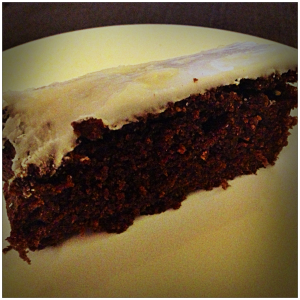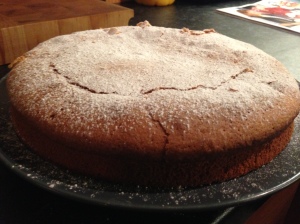
Coffee & Walnut Layer Cake, Nigella Lawson’s ‘Kitchen’
We hold regular charity bake sales in our team at work, and trial and error has taught me that this cake goes fast! It’s really does seem to be one of the best sellers. In fact, I baked this last night to be sold today…and within 20 mins of the sale someone bought the whole cake. THE WHOLE CAKE! (It was for someone’s birthday just in case you’re concerned about their general well-being) . And if you needed any more convincing, Paul doesn’t like nuts but somehow loves this cake. It is one of the easiest cakes to make, and whilst the nutty flavour is quite subtle, the espresso really makes this cake sing. The buttercream frosting is really simple too, but really adds to the overall taste! (I’m not really an icing fan, but this converted me to the idea). The first time I made this I couldn’t get espresso powder, but I really would advise searching it out. I found a Percol espresso powder at the supermarket which I now use, but Nescafe also do one that’s quite widely available too.
This cake is from Nigella Lawson’s book, Kitchen, which is actually one of my favourite Nigella books. And whilst I’ve listed the recipe below, it’s also available online on her website here.
Coffee and Walnut Layer Cake (serves 8, but that’s according to Nigella! Her portions are huge, so it can probably serve more!)
Ingredients
For the sponge
- 50g walnuts (pieces)
- 225g caster sugar
- 225g unsalted, softened butter (plus some for greasing)
- 200g plain flour
- 4 tsp espresso coffee
- 2.5 tsp baking powder
- ½ tsp bicarbonate of soda
- 4 medium eggs
- 2 tablespoons milk
For the buttercream frosting
- 350g icing sugar
- 175g unsalted, softened butter
- 2.5 tsp espresso coffee
- 1 tbsp water (boiling)
- 25g walnuts (halves)
Method
Preheat the oven to 180°C/gas mark 4.
Butter 2 20cm/8” sandwich tins and line the base of each with baking parchment.
Put the walnut pieces and sugar into a food processor and blitz to a fine nutty powder.
Add the butter, flour, espresso powder, baking powder, bicarb and eggs and process to a smooth batter.
Add the milk, pouring it down the funnel with the motor still running, or just pulsing, to loosen the cake mixture: it should be a soft, dropping consistency, so add more milk if you need to. (If you are making this by hand, bash the nuts to a rubbly powder with a rolling pin and mix with the dry ingredients; then cream the butter and sugar together, and beat in some dry ingredients and eggs alternately and, finally, the milk.)
Divide the mixture between the 2 lined tins and bake in the oven for 25 minutes, or until the sponge has risen and feels springy to the touch.
Cool the cakes in their tins on a wire rack for about 10 minutes, before turning them out onto the rack and peeling off the baking parchment.
When the sponges are cool, you can make the buttercream.
Pulse the icing sugar in the food processor until it is lump free, then add the butter and process to make a smooth icing.
Dissolve the instant espresso powder in 1 tablespoon boiling water and add it while still hot to the processor, pulsing to blend into the buttercream. (If you are doing this by hand, sieve the icing sugar and beat it into the butter with a wooden spoon. Then beat in the hot coffee liquid).
Place 1 sponge upside down on your cake stand or serving plate.
Spread with about half the icing; then place on it the second sponge, right side up (i.e. so the 2 flat sides of the sponges meet in the middle) and cover the top with the remaining icing in a ramshackle swirly pattern.
This cake is all about old-fashioned, rustic charm, so don’t worry unduly: however the frosting goes on is fine. similarly, don’t fret about some buttercream oozing out around the middle: that’s what makes it look so inviting.
Gently press the walnut halves into the top of the icing all around the edge of the circle about 1cm apart
Eat a piece before it all goes…






